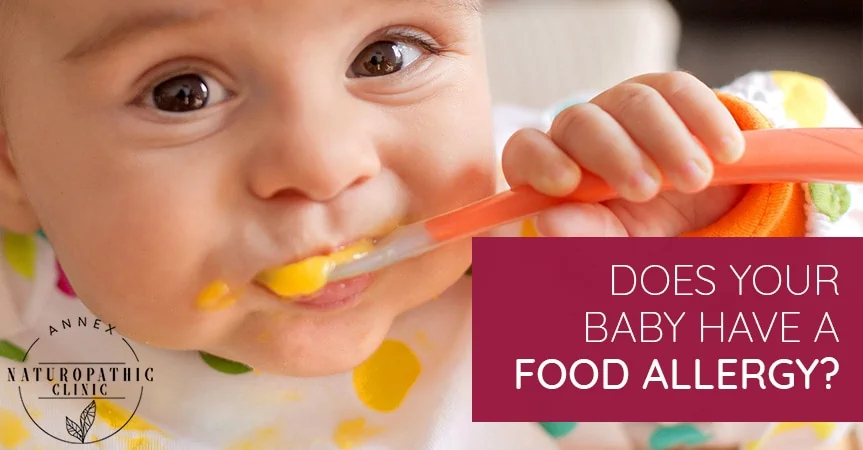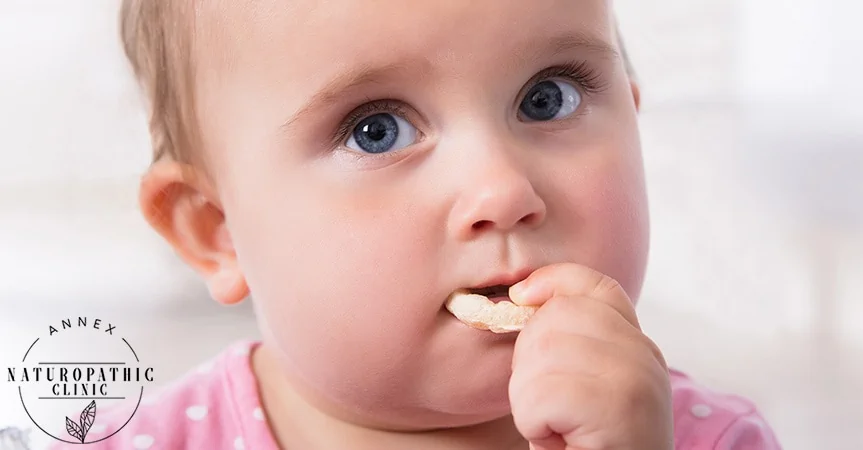What you eat affects not only you and your health, but the health of your baby as well.
Food allergies and sensitivities are a tricky one to figure out – they are difficult to pinpoint and difficult to effectively treat.
If you suspect your baby is experiencing a food allergy, contact a Toronto children’s health naturopath for natural solutions.
In the meantime, let’s take a closer look at infant food allergies and sensitivities.
What are the symptoms? How are they developed? And how can you help your baby feel better?
Read on to find out.
Do Food Allergies Pass Into Your Breast Milk?
Certain food proteins pass to your baby through your breast milk. This can result in an allergic or sensitive reaction in your baby to that food.
Additionally, if one of the child’s parents have food allergies, the infant is more likely to have one as well.
Some foods are more likely to cause reactions than others. These include cow’s milk, peanuts or tree nuts, gluten, soy, eggs, corn, fish, and shellfish.
In babies and young children, the most common food sensitivity/allergy to develop is to cow’s milk.
A recent study conducted by the World Allergy Organization found that infants who are breast-fed exclusively are less likely to develop an allergy/sensitivity to cow’s milk.
The study concludes that mothers of breast-fed infants with a cow’s milk allergy should continue breast-feeding, but avoid foods containing cow’s milk protein.
What Happens When Your Baby Has A Food Allergy?
There are various types of food allergies and immune reactions that may affect your baby.
The true allergy is the rarest and most serious form of allergic reaction.
This immune reaction (typically known as an anaphylactic reaction) happens quickly – within 2 hours of consuming food – and can result in anaphylaxis.
Food sensitivities are much more common than true allergies and the symptoms they produce are much less scary. Their symptoms can occur anywhere between a few hours to a few days after food intake.
Although food sensitivity reactions are immediately life-threatening, they have a few possible effects that can affect your body in the long term. Common consumption these foods can increase gut inflammation, alter your baby’s immune balance, leading to discomfort and weakened immunity in your child.
When your little one is suffering from a food allergy or sensitivity, the symptoms can manifest in many different ways.
Let’s take a more in-depth look at the symptoms of infant food allergies.
Symptoms Of Food Allergies In Babies
The primary symptom of the rare and life-threatening true food allergy is anaphylaxis. It’s important to be aware of the signs and symptoms.
Symptoms of anaphylaxis include:
• Difficulty swallowing and breathing
• Puffy, swollen lips and eyes
• Hives
• Diarrhea, vomiting, and/or abdominal pain
• Itchy mouth
If your baby is experiencing the above symptoms, contact emergency health services immediately.
As we mentioned earlier, the symptoms of food sensitivity reactions are more delayed and less serious than true allergies.
Typically, the following symptoms will occur if your little one is experiencing a reaction to a food sensitivity.
The most common signs of food sensitivity in an infant include:
• Dermatological symptoms – hives, rashes, and eczema
• Gastrointestinal symptoms – diarrhea, constipation, failure to thrive, colic or irritability, vomiting, food protein-induced enterocolitis syndrome (or FPIES), lack of appetite
• Respiratory symptoms – chronic cough, runny nose, shortness of breath, wheezing, asthma, recurring illnesses (cold, flu, ear infections)
What To Do If Your Baby Shows Food Allergy Symptoms?
If you suspect that your baby may have an anaphylactic reaction to a certain food, consult your primary health care provider. They will refer you appropriately to an allergist that can perform the necessary testing to determine anaphylaxis. Do not attempt to figure this out on your own.
If you suspect your baby may be experiencing a food sensitivity, there are steps you can take to determine which food is causing the reaction.
The best method, and the only way to get to the bottom of your child’s symptoms, is an elimination diet.
1. The Elimination Diet
The elimination diet is exactly what it sounds like. You eliminate certain foods from your diet. Then, you slowly start adding them back in to figure out which one is the culprit.
It’s important to eliminate all the potentially allergens at the same time, instead of one at a time.
This is to give your baby the best chance to get healthy and feel better as soon as possible.
The foods you should eliminate in such a diet include:
• Dairy
• Eggs
• Soy
• Gluten
• Peanuts and tree nuts
• Fish and shellfish
• Corn
• Nightshades, a family of fruits/vegetables including tomatoes, eggplants, and peppers
• Caffeine
• Sugar
• Alcohol
• Citrus
Although it may be stressful, the elimination diet may leave you feeling a lot better.
It’s possible you and your child may share a food sensitivity. This is because of the way your baby is exposed to your immune cells during pregnancy and during breastfeeding. Therefore, if your baby is exclusively nursing, then you would be the one doing the elimination diet. If the baby is eating food, and is nursing, both mom and baby would have to do the elimination diet.
It’s crucial you eat enough calories, both for your own health and also to maintain a good supply of breast milk.
There are many delicious and nutritious recipes available online that can make the elimination diet a lot easier to master.
You should continue eating without any of the above foods for 5-8 weeks before beginning the next step of the process. This step is reintroducing the potential allergenic foods to your diet.
2. Slowly Reintroduce Eliminated Foods
After you’ve eliminated potential allergens from your diet for the allotted period, it’s time to slowly start bringing them back into your life.
It’s key to test one food at a time, and monitor the health of you and your baby.
If either of you experience any symptoms at all after the first or second meal including the test food, stop eating it. After that, keep an eye out for further reactions.
It can be helpful to keep a written log of what foods you’re testing, and what reactions are occurring in you or your baby.
If your baby still reacts to a specific food through this process, remove it from your diet completely for 6 months. After that, test it again.
The best and safest way to go about the elimination diet is to do it under the supervision of your naturopathic doctor. Call us to find out more about the specifics of this process.
Contact Annex Naturopathic
Food sensitivities and allergies can be frustrating and difficult to pin down. This is especially true when they’re affecting the health and well-being of your baby.
But you’re not alone – there are natural solutions available to you and your little one.
If you have questions about food allergies, sensitivities, or the elimination diet, contact us at Annex Naturopathic.
We’d love to get to know you and your baby, and help you diagnose and overcome tricky food sensitivities.
If you or your infant are experiencing any of the signs or symptoms of food allergies, we can help.
Contact Annex Naturopathic today.



